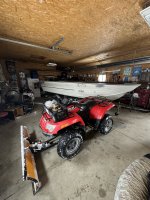SlipperyOar
Petty Officer 2nd Class
- Joined
- Apr 12, 2024
- Messages
- 141
I’m at the point where I’m ready to put some fresh colour onto my aluminum boat. I’ve read through almost every thread regarding painting aluminum with lots of notes taken but I have a few additional questions that haven’t been answered. Currently the boat has 99% of the existing paint on it, a few spots are bare aluminum from scratches and what not. I’ve began feathering out any scratches to make the surface flush and once feathered I have used a vinegar/water mix following by some etching primer out of a spray can.
I plan on washing up the entirety of the surface with some soap and water, then 220 grit sandpaper on the random orbital sander and then cleaning the surface with some sort of mineral spirit.
Would a 2K epoxy primer (high build) be best to apply a solid primer coat(s) first followed by the top coats. Or do i need to line if the surface is mostly well adhered existing paint that’s been scuffed up?
does anyone have suggestions on the process, and the paint and primer types to use to give this its best results? I’ve got fair experience with painting and will be using a HVLP gun for paint and primer application.
Hoping to find a good Honolulu blue and silver to represent my Detroit lions while out on the water!
I plan on washing up the entirety of the surface with some soap and water, then 220 grit sandpaper on the random orbital sander and then cleaning the surface with some sort of mineral spirit.
Would a 2K epoxy primer (high build) be best to apply a solid primer coat(s) first followed by the top coats. Or do i need to line if the surface is mostly well adhered existing paint that’s been scuffed up?
does anyone have suggestions on the process, and the paint and primer types to use to give this its best results? I’ve got fair experience with painting and will be using a HVLP gun for paint and primer application.
Hoping to find a good Honolulu blue and silver to represent my Detroit lions while out on the water!



























